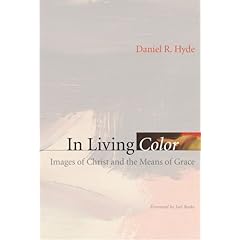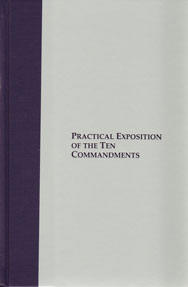 Several months back, I got a copy of Danny Hyde's excellent new book that concerns images of Jesus Christ, In Living Color: Images of Christ and the Means of Grace, and have since found it a wonderfully edifying and clear exposition of an almost totally-forgotten doctrine. How many of us who grew up in evangelical Christian homes in the 70's did NOT have what I lovingly call the "Jesus Christ senior portrait" on their parents bedroom wall or Dad's study? Like them, so did I. Churches, too, got into the act, and many had (and still have!) them in their sancutaries and fellowship hall. Who ever would have thought that images of Christ were inappropriate or idolatrous? It is sad to say that none did, and I certainly had no different ideas until I began learning Reformed thought in the early 90's in suburban Chicago in the PCA. It was there I came into contact with the Westminster Standards and came to a rapid conviction that images of Christ (and the Godhead in general) were right out. Convincing others of that fact, though, has been nearly impossible - this is where Hyde's book is most helpful. He traces the Bible's teaching on images, what he calls "Man's Media", and then follows up with "God's Media" - that is, preaching of the Holy Word of God, and the proper administration of the sacraments. These are the means of "imaging" Christ that God has ordained - and no more.
Several months back, I got a copy of Danny Hyde's excellent new book that concerns images of Jesus Christ, In Living Color: Images of Christ and the Means of Grace, and have since found it a wonderfully edifying and clear exposition of an almost totally-forgotten doctrine. How many of us who grew up in evangelical Christian homes in the 70's did NOT have what I lovingly call the "Jesus Christ senior portrait" on their parents bedroom wall or Dad's study? Like them, so did I. Churches, too, got into the act, and many had (and still have!) them in their sancutaries and fellowship hall. Who ever would have thought that images of Christ were inappropriate or idolatrous? It is sad to say that none did, and I certainly had no different ideas until I began learning Reformed thought in the early 90's in suburban Chicago in the PCA. It was there I came into contact with the Westminster Standards and came to a rapid conviction that images of Christ (and the Godhead in general) were right out. Convincing others of that fact, though, has been nearly impossible - this is where Hyde's book is most helpful. He traces the Bible's teaching on images, what he calls "Man's Media", and then follows up with "God's Media" - that is, preaching of the Holy Word of God, and the proper administration of the sacraments. These are the means of "imaging" Christ that God has ordained - and no more.After read
 ing this work, which I trust will be a welcome resource for any who have to deal with this question in their families or churches, I decided to pull out another excellent resource - James Durham's Exposition of the Ten Commandments, and check again his remarks on the 2nd commandment. They are extremely helpful, and I offer a couple here.
ing this work, which I trust will be a welcome resource for any who have to deal with this question in their families or churches, I decided to pull out another excellent resource - James Durham's Exposition of the Ten Commandments, and check again his remarks on the 2nd commandment. They are extremely helpful, and I offer a couple here.Durham is careful to delineate the issues concerning images and their prohibition in the 2nd commandment - which images are forbidden, and which are allowable. He argues clearly that many images are most certainly allowed under the 2nd commandment - that two things are primarily in view:
"Though making of images simply is not unlawful and discharged by this commandment, yet thereby every representation of God (who is the Object to be worshipped) and every image religiously made use of in worship [emphasis in the original] is condemned... (1) Because such images cannot but beget carnal thoughts of God (as Acts 1:7, 29), contrary to his commandment. (2) Because God discovered hijmself (Deut. 4:15-16, etc.) by no likeness, but only by his Word, that they might have no ground of likening him to anything. (3) Because it is impossible to get a bodily likeness to set him out by, who is a Spirit and an infinite Spirit. So then, every such image must be derogatory to God, as turning the glory of the invisible God to the shape of some visible and corruptible creature; which is condemned (Rom. 1:22-23), for every image supposes some likeness." (p. 95)Images of God - in general - Durham says, are forbidden. This he says flatly - but then goes on to describe images of Jesus Christ and why they are forbidden as well, despite what seem to be arguments made in his day that resemble those made in ours. Durham writes that all images purporting to portray God in any way or in any of his persons are condemned:
"All representing of the persons as distinct, as to set out the Father (personally considered) by the image of an old man, as if he were a creature, the Son under the image of a lamb or young man; the Holy Ghost under the image of a dove: all which wrongs the Godhead exceedingly. Andalthough the Son was, and is man, having taken on him that nature, and united it to his Godhead, yet he is not a mere man. Therefore that image, which holds forth one nature, and looks like any man in the world, cannot be the representation of that person which is God and Man." (p. 95)That is as succinct an explanation as can be given.. images of Christ are simply wrong, because they either divide the humanity of Christ from his Divinity, or they seek to portray his Divinity as the second person of the Triune God. Each is condemned. Durham writes further, stating that the existence of such an image also has problems - even if it is accepted as "Christ's portraiture."
"...shall that be called Christ's portraiture? Would that be called any other man's portraiture, which were drawn at men's pleasure, without regard to the pattern? Again, there is no use of it. For either that image behooved to have but common estimation with other images, and that would wrong Christ; or a peculiar respect and reverence, and so it sins against this commandment that forbids all religous reverence to images. But he being God, and so the Object of worship, we must either divide his natures, or say that the image or picture does not represent Christ." (p. 96)Many times I hear people argue (not dealing with the above objections, which are outside the thoughts of most, I suspect) that images of Christ (and even indeed of God the Father) are fine as long as they don't bow down to worship them as such. Even so, as many of them will admit, such images draw them into reverential thoughts and private worship of Christ, as an image of Christ (were it legitimate and allowable) ought to, as Durham wrote above.
This second objection misses the point.. worship of images does not require the worshipper to be caught in the thought that the image itself IS a god of some sort... even worship of the true and living God, if images are used to direct the thoughts, or as aids in his worship, is strictly forbidden by this commandment. Durham swiftly gets rid of this objection by 1) remarking that if the image itself is worshipped as though it properly were a god, then that would not be a breaking of the second commandment, but the first!
"The first was more gross, when worship was given to the image, as being some godhead of itself. Thus some think the images of Baal, Ashtaroth, etc., and particular images, that have special names, were worshipped. Thus are men said properly to worship the works of their hands. This is against the first commandment." (p. 97)Rather, Durham argues, the issue concerning worship of the true and living God (separately considered, or considered in His Trinity) through images is forbidden. Worship that is well directed, but practiced contrary to God's commandment is simply forbidden - much of Durham's exposition of the second commandment, in fact, is directed at this score in general. Durham remarks,
"There was a worshipping of images as representing God, and so the worship was gone about as part of service done to the true God; such was (in conformity to the heathen's practice) the worship given to the calf (Ex. 32:1-7), and such were the groves and sacrificings in the high places (2 Chron. 33:17)....this may be made to appear from the command where the Lord forbids not only the worship of idols, but of himself by images (Deut. 12:31). Thou shalt not do so to the Lord thy God. That is, 'Thou shalt not worship me by images, as the heathen do their gods.' And therefore this is not only possible, but is also, and that most certainly, a grievous guilt." (pp. 99-101)Images of the Godhead - whether for the express purpose of worshipping Him, or for the mere possession of them (which, because they excite devotion, and a worshipful frame in the believer, are no different than the first case) - are quite clearly condemned in Scripture. Hyde and Durham, two men 400 years apart, treat the subject differently, but with the same conclusion. Let us worship God aright and take care, however unpopular, to obey Him in ALL that he commands.


1 comments:
Just received the Durham work from Naphtali Press today. Look forward to reading it.
Post a Comment